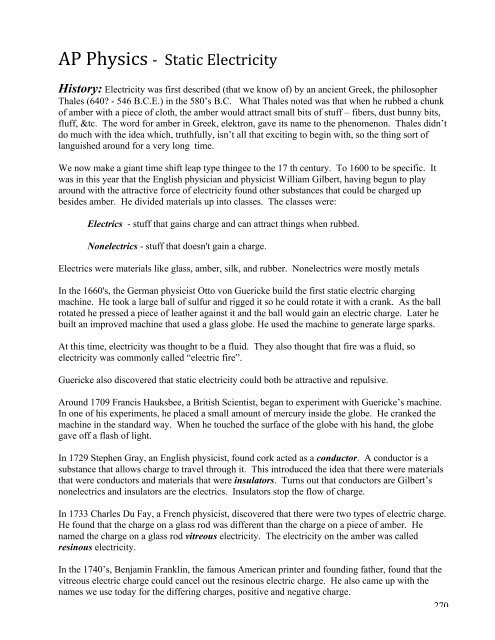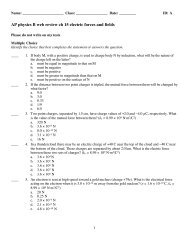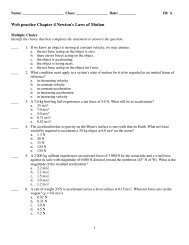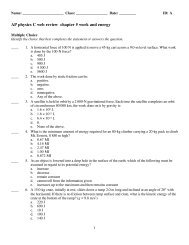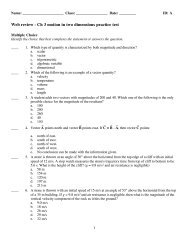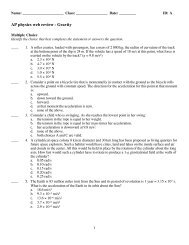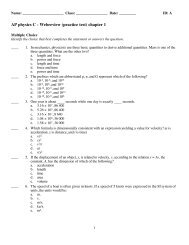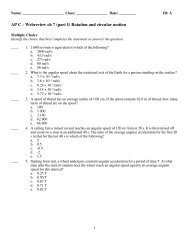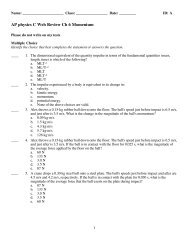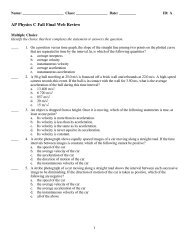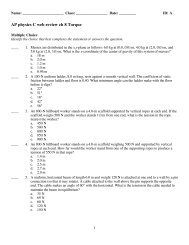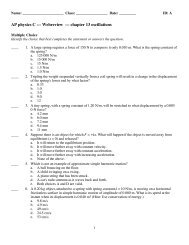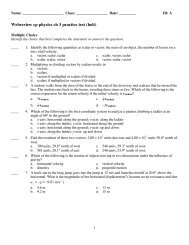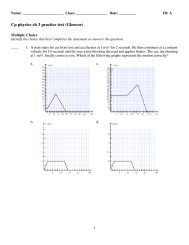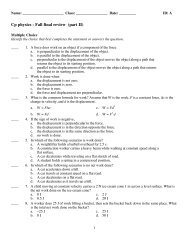AP Physics
AP Physics -â Static Electricity - Planet Holloway
AP Physics -â Static Electricity - Planet Holloway
You also want an ePaper? Increase the reach of your titles
YUMPU automatically turns print PDFs into web optimized ePapers that Google loves.
<strong>AP</strong> <strong>Physics</strong> -‐ Static Electricity <br />
History: Electricity was first described (that we know of) by an ancient Greek, the philosopher<br />
Thales (640? - 546 B.C.E.) in the 580’s B.C. What Thales noted was that when he rubbed a chunk<br />
of amber with a piece of cloth, the amber would attract small bits of stuff – fibers, dust bunny bits,<br />
fluff, &tc. The word for amber in Greek, elektron, gave its name to the phenomenon. Thales didn’t<br />
do much with the idea which, truthfully, isn’t all that exciting to begin with, so the thing sort of<br />
languished around for a very long time.<br />
We now make a giant time shift leap type thingee to the 17 th century. To 1600 to be specific. It<br />
was in this year that the English physician and physicist William Gilbert, having begun to play<br />
around with the attractive force of electricity found other substances that could be charged up<br />
besides amber. He divided materials up into classes. The classes were:<br />
Electrics - stuff that gains charge and can attract things when rubbed.<br />
Nonelectrics - stuff that doesn't gain a charge.<br />
Electrics were materials like glass, amber, silk, and rubber. Nonelectrics were mostly metals<br />
In the 1660's, the German physicist Otto von Guericke build the first static electric charging<br />
machine. He took a large ball of sulfur and rigged it so he could rotate it with a crank. As the ball<br />
rotated he pressed a piece of leather against it and the ball would gain an electric charge. Later he<br />
built an improved machine that used a glass globe. He used the machine to generate large sparks.<br />
At this time, electricity was thought to be a fluid. They also thought that fire was a fluid, so<br />
electricity was commonly called “electric fire”.<br />
Guericke also discovered that static electricity could both be attractive and repulsive.<br />
Around 1709 Francis Hauksbee, a British Scientist, began to experiment with Guericke’s machine.<br />
In one of his experiments, he placed a small amount of mercury inside the globe. He cranked the<br />
machine in the standard way. When he touched the surface of the globe with his hand, the globe<br />
gave off a flash of light.<br />
In 1729 Stephen Gray, an English physicist, found cork acted as a conductor. A conductor is a<br />
substance that allows charge to travel through it. This introduced the idea that there were materials<br />
that were conductors and materials that were insulators. Turns out that conductors are Gilbert’s<br />
nonelectrics and insulators are the electrics. Insulators stop the flow of charge.<br />
In 1733 Charles Du Fay, a French physicist, discovered that there were two types of electric charge.<br />
He found that the charge on a glass rod was different than the charge on a piece of amber. He<br />
named the charge on a glass rod vitreous electricity. The electricity on the amber was called<br />
resinous electricity.<br />
In the 1740’s, Benjamin Franklin, the famous American printer and founding father, found that the<br />
vitreous electric charge could cancel out the resinous electric charge. He also came up with the<br />
names we use today for the differing charges, positive and negative charge.<br />
270
Electric Basics: Electricity is an aspect of one of the four fundamental forces in the universe,<br />
the electromagnetic force. It involves attraction and repulsion between charged particles. The<br />
source of the charge is two subatomic particles, the electron and the proton. Electrons have a<br />
negative charge and protons have a positive charge. The magnitude of the charge is the same for<br />
each particle. We say that an electron has a charge of “minus one” or – 1. The proton has charge of<br />
“plus one” or + 1. All this minus one or plus one stuff is mainly a chemistry thing. In physics we<br />
use a different unit for charge, as we shall see.<br />
Atoms are electrically neutral – they have no charge. This is because they have the same number of<br />
electrons as protons and their charges cancel each other out. If an atom gains or loses electrons, it<br />
gains a charge and becomes an ion. We say it is ionized. Ions are a really big deal in chemistry, but<br />
not much of a thing in physics.<br />
Different elements vary widely in their ability to gain or lose electrons. This is what is involved<br />
when you rub an object with a cloth to give it a charge. You blow up a rubber balloon and rub it<br />
with a bit of wool. The balloon is more attractive to electrons than is the cloth, so during the<br />
rubbing, electrons from the cloth jump onto the balloon. This gives the balloon a negative charge<br />
because it now has more electrons than protons. The cloth gains a positive charge (it has more<br />
protons than electrons so the net charge is positive). Rubber objects almost always gain a negative<br />
charge during rubbing operations.<br />
A glass rod rubbed with silk will gain a positive charge.<br />
Rubber and glass rods are often used in experiments to establish known charges for use in<br />
comparison tests.<br />
The generation of charge by friction is called triboelectrity. Isn’t it wonderful how physics has<br />
phancy names for everything?<br />
Charged objects exert forces on one another and obey the fundamental law of static electricity:<br />
Fundamental Law of Static Electricity ≡ Like charges repel; opposite<br />
charges attract.<br />
Two balloons that have been given a negative charge will repel each other. A negatively charged<br />
object will attract a positively charged object.<br />
Here’s another key concept, the principle of conservation of charge.<br />
Principle of Conservation of Charge ≡ charge is not created or destroyed,<br />
merely transferred from one system to another.<br />
Back to Insulators and Condcutors:<br />
Conductors are usually metals. The charge is carried through the material by the free electrons that<br />
metals have because of their metallic bonds.<br />
271
Insulators are non-metals; materials like plastic, rubber, ceramics, &tc. These substances have their<br />
electrons tightly bound in their chemical bonds. The charge can’t go anywhere in these substances<br />
because there’s nothing to carry the charge. The electrons are not free to move, don’t you see.<br />
When a charge is placed on an insulator, the charge stays where you put it. When a charge is placed<br />
on a conductor it will immediately spread out over the entire object (actually, as we shall see, it<br />
travels to the outer surface of the conductor).<br />
Electrolytes are liquid solutions that can conduct electricity. The electrolyte contains ions that<br />
transfer charge.<br />
Charging Objects: There are two methods that can be used to charge objects; charging by<br />
conduction and charging by induction.<br />
Charging by conduction is very simple. An object is given a charge – we rub a rubber rod with a<br />
rabbit fur. The rod now has a negative charge. We also have a metal sphere attached to an<br />
insulated stand. We touch the sphere with the charged rod and some of the extra electrons on the<br />
rod will flow onto the sphere, giving it a negative charge. A common way to transfer charge by<br />
conduction is through the use of a small metal disc attached to an insulated rod. This device is<br />
called a proof plane (the <strong>Physics</strong> Kahuna has no idea why). When it is touched to a charged object<br />
it gains the same charge by conduction. This charge can then be transferred to some other object or<br />
tested.<br />
Charging by induction is a bit more complicated. We start out with a charged object and an<br />
uncharged object. Charge is transferred, but there is no physical contact between the two objects.<br />
There are two ways to do this. Let’s look at the first method. We have a negatively charged rubber<br />
rod and an insulated metal sphere. You cannot charge an insulator by induction, the method works<br />
only with objects that have conductive surfaces.<br />
1. Bring the charged object near the insulated sphere. The sphere is electrically neutral –<br />
same number of electrons as protons, duh. The negative charge on the rod will repel the<br />
free electrons on the sphere’s surface, however. They will collect on the opposite side of<br />
the sphere from the rod - they’re trying to get as far away from the negative charge on<br />
272
the rod as they can. Remember, in a conductor, they are free to move about. If the<br />
charged rod is moved away from the sphere, the electrons will redistribute themselves<br />
over the surface and the sphere will remain electrically neutral. With the charged rod<br />
near, the sphere is polarized – one side has a positive charge and the other side has a<br />
negative charge. Even though the net charge on the object is still zero, so the thing is<br />
still electrically neutral.<br />
2. Keeping the charged rod near the sphere (but not touching it) touch the opposite side of<br />
the sphere with a finger. This will “ground” the sphere. The electrons, wanting to get<br />
away from the negative charge on the rod (like objects repel) will flow into your finger.<br />
This is because you are a big electron sink that the electrons can go into. The earth is an<br />
even bigger sink, so anytime electrons are given a path to travel into a big sink we say<br />
they have been “grounded”. The big sink is a “ground”.<br />
3. Take the finger away and remove the rod.<br />
4. The sphere, having lost a good many of its electrons, will now have a positive charge. It<br />
is positive because there are more protons than electrons. It has been charged by<br />
induction.<br />
The second induction method involves two insulated objects.<br />
1. Place the two objects in physical contact with one another – they must touch. In this<br />
example we have two insulated conductive spheres. These are metal spheres on<br />
insulated stands.<br />
2. Bring a charged object to the side of one of the spheres. Don’t touch the sphere; just<br />
bring the object nearby. In this example we have a negatively charged rubber rod.<br />
273
Electrons in the first sphere, the one near the charged rod, are repelled and will move<br />
into the second sphere. They try to get as far away from the rod as possible. As long as<br />
the rod near one of the spheres, the two sphere system will be polarized.<br />
3. Move the sphere opposite of the one near the charged rod away from the other sphere so<br />
they no longer touch. The sphere you moved will have an excess of electrons, the ones<br />
from the other sphere, and will have a negative charge. The other sphere, having lost<br />
some of its electrons, will have a positive charge.<br />
4. Pull the rod away. The two spheres are now charged – charged by induction!<br />
Polarizing Objects: Briefly mentioned in the explanation of charging by induction was the<br />
term “polarized”. Polarizing is important in many of the electrostatic phenomenon that we have<br />
played around with. For example, why did the rubber rod attract bits of paper? The rubber rod had<br />
a charge, but the paper bits did not, they were quite neutral,<br />
wasn’t they? Why did the charged balloon stick to a person’s<br />
clothing or the wall? Why was the 2 x 4 attracted to the charged<br />
PVC pipe?<br />
These things happen because of polarization. When you bring a<br />
charged object near an uncharged object, the uncharged object<br />
gets polarized. Think of the molecules that make up the<br />
uncharged object. The molecule has no charge. But when the<br />
charged rod comes near it, electrons are either attracted or<br />
repelled toward the rod. This motion happens because of the<br />
nature of the covalent bond, you know, the old “sharing of<br />
electrons” thing. So the electrons try to get away form a<br />
negatively charged object, or they are attracted to a positively charged object. The net effect is to<br />
cause the molecules to have a positive side and a negative side, even though overall it is electrically<br />
neutral. As long as the charged object is nearby, the molecule stays polarized.<br />
The charged balloon sticks to the wall because it polarizes the molecules in the wall and the<br />
negative charge of the balloon is attracted to the positive end of the wall’s molecules.<br />
Sparks: One of the things you will have observed is that when a charge goes from one object to<br />
another, it can travel through the air in the form of a spark. Sparks can be barely noticeable or they<br />
can be so massive that it is impossible to ignore them, like a lightening bolt.<br />
The bigger the charge difference between two objects, the more the charge wants to move. If the<br />
charge is big enough, it will ionize the air molecules between the objects. The charge can then<br />
travel through the ionized air. This is what we call a spark.<br />
The Electrophorus: The electrophorus is a wonderful device that was invented by<br />
Alessandro Volta in 1775. He called it the elettrofore perpetuo. It seemed to an almost endless<br />
source of charge.<br />
The electrophorus has two parts: a base made from an insulator and a metal plate that has an<br />
insulated handle.<br />
274
Here’s how to use the electrophorus.<br />
1. The first step is to charge the insulator base by rubbing it<br />
wait a cloth or fur. Then you, holding onto the insulated<br />
handle, place the metal plate onto the charged insulator<br />
base.<br />
2. The metal plate will be polarized. Free electrons will<br />
collect on the upper surface of the metal plate.<br />
3. Touch the top surface of the metal plate with a finger while the plate sits on the base.<br />
Immediately remove your finger from the plate after the touch. You should feel a small spark.<br />
See, here’s what happened, when you touched the plate, the free electrons had a path to ground<br />
and went into your finger. The plate now has a positive charge.<br />
4. Pick the plate up with the handle. It is charged and you can transfer the charge to some other<br />
object.<br />
The plate did not remove any charge from the base, so if you place it on the base again, you can<br />
repeat the charging operation again and again. To the 18 th century physicists, it seemed like a<br />
magical source of charge. Sadly, however, the charge on the insulated plate will eventually leak off<br />
into the air, so you can’t use it forever. On a humid day, you might be lucky to charge the plate two<br />
or three times before the charge leaks off. This is because humid air ionizes much faster than does<br />
dry air.<br />
Electroscopes: A useful device to measure charge is the electroscope. There are several<br />
different styles that are available. Each of them will indicate whether an object is charged.<br />
275
Foil on thread type: One type is made from a small, light piece<br />
of metal foil that is attached to an insulated thread. A charged<br />
object is brought near the foil. The foil will be polarized and<br />
attracted to the charged object. When it touches the charged<br />
object it will be charged by conduction. Now having the same<br />
charge, it will be repelled.<br />
The angle formed by the thread with the vertical is proportional<br />
to the charge. If the foil is charged by a rubber rod, then one<br />
knows that it has a negative charge. An unknown charge can<br />
now be brought near the foil. If the charged foil is attracted, then you know that the object<br />
has a positive charge – remember, unlike charges attract. If the foil is repelled, then you<br />
know that the object has a negative charge – like charges repel.<br />
Twin hanging leaf type: This type of electroscope is usually enclosed in a transparent box<br />
or beaker. A metal rod has a metal ball mounted on its top. We will call this the electrode.<br />
The rod goes into the box where it has two very thin metal foil<br />
leaves attached to it. The metal leaves hang downward and are<br />
separated by a small space. They are both attached to the rod.<br />
A negatively charged rod is brought to the electrode on the top. The<br />
electrode is charged by conduction. The charge travels throughout<br />
the rod and into the metal foil leaves. They each have a negative<br />
charge and will repel each other. This means that they will lift away<br />
from the vertical. The angle they make is proportional to the<br />
charge.<br />
You charge up an electrophorus and give it a positive charge. You<br />
bring it to an electroscope to transfer the charge. How does a positive<br />
charge transfer?<br />
As the electrophorus nears the ball on the electrode of the<br />
electroscope, the electroscope becomes polarized. Free electrons<br />
collect on the ball, attracted to the positive charge on the plate of the<br />
electrophorus.<br />
The electrophorus has a pretty good charge, so usually the electrons will be so attracted to the plate<br />
as it nears that they will ionize the air and jump to the electrophorus in the form of a spark. The<br />
electrophorus is slightly less positive having collected some electrons and the electroscope is<br />
positive, having lost free electrons.<br />
276
Leyden Jar: Ewald George von Kleist in 1745 and Pieter van Musschenbroek in 1746<br />
developed this wonderful device. It was the first method discovered to store a significant amount of<br />
charge for later use. The Leyden jar was an accidental discovery. Kleist apparantly thought that<br />
electricity was a liquid. It made sense that it might dissolve in water, so an attempt was made to put<br />
some charge in a beaker of water. He hooked a wire in the beaker to an electrostatic generating<br />
machine. Holding the beaker in his hand, he cranked up the machine to generate charge. It turned<br />
out that electricity did go into the beaker, but it didn’t dissolve into the water. This was discovered<br />
a bit later when an assistant touched the wire in the beaker while holding the outside of the thing<br />
and got a tremendous shock. The shock was so painful and shocking that Kleist gave up on the<br />
whole thing.<br />
The Leyden jar was the first capacitor. The first one wasn’t a real<br />
proper Leyden jar, but it certainly acted like one.<br />
A Leyden jar is simply a jar that has a conductor on the inside lining its<br />
inner surface and a conductor on the outside surface. An electrode<br />
sticks up above the jar through the lid. The electrode is connected to<br />
the inner conductor.<br />
Here is the classic Leyden jar. It has a metal foil lining on the inside<br />
lower half and a similar coating on the outside. The electrode in the<br />
center makes electrical contact with the inside metal layer via a chain.<br />
The key thing though is that you must have two conductors separated<br />
by an insulator. Another common way to make a Leyden jar (the one<br />
we will use) is to have an electrolyte solution on the inside and a foil<br />
lining on the outside. The electrode pokes down into the electrolyte.<br />
Recall that electrolytes are solutions that conduct electricity. We will<br />
use salt water.<br />
Charge and the Leyden Jar: When a charged object is brought near the center electrode,<br />
the inner conductor becomes polarized. In the drawing (which has a greatly exaggerated conductor<br />
277
thickness), a positive charge is brought near the electrode. The free electrons flow to the top ball,<br />
attracted by the positive charge. The inner conductor has a positive charge because the free<br />
electrons have made their departure. The outer conductor is also polarized. Just across the insulator<br />
is a strong positive charge, so the free electrons are attracted to the surface of the insulator.<br />
To charge the Leyden jar, the outside conductor must be grounded as the charged object is brought<br />
to the electrode ball. Usually the charge will jump to the electrode in a spark.<br />
If the outside of the jar isn’t grounded, you can’t store charge in the jar.<br />
The grounding is usually done by holding the jar in you hand.<br />
With a ground (your hand) attached to the outer conductor, electrons flow<br />
from the ground into the outer conductor. The free electrons at the top of the<br />
electrode flow into the positively charged object. You end up with a negative<br />
charge on the outer conductor and a positive charge on the inner conductor.<br />
They stay in place because they attract each other across the insulator. You<br />
can pick it up by the outer conductor and the charge stays in place.<br />
This is how the Leyden jar stores charge.<br />
278


